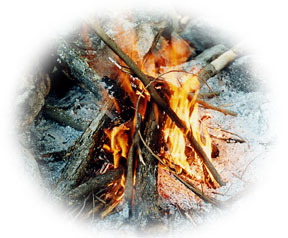
This information came from This Week in California Wild.

Barbecued Bones Show Early Mastery Of Fire
The remains of an ancient African barbecue suggest our ancestors
had learned to control fire nearly 1.5 million years ago. Using
a new method to analyze heated bone, researchers from the Transvaal
Museum in Pretoria, South Africa, and Williams College in Williamstown,
Pennsylvania, have pushed back the first instance of controlled
fire use by a million years. The researchers analyzed burned bones
collected in South Africa's Swartkrans region in 1998. Some bones
appeared to have been heated to higher temperatures than others.
Hearth fires can attain temperatures nearly 300 degrees Celsius
higher than brush fires. For this reason, scientists suspected
the bones were evidence of early fire use. Now, a technique called
electron spin resonance analysis proves that the bones must have
been heated to intense campfire temperatures in order to reduce
so much of the material to pure carbon. One of two pre-human species
living in the area at that time, Australopithecus robustus
and Homo erectus, likely cooked the bones. The next-oldest
evidence of fire use, in Zhoukoudian, China, is 400,000 to 250,000
years old.
Access the related BBC News article on the first evidence
of fire use by humans.
http://news.bbc.co.uk/2/hi/science/nature/3557077.stm
More evidence on ancient fires:
http://www.dichotomistic.com/mind_readings_fire.html
http://megafauna.com/the-book/part-iii/fire/
We hope the information on the PrimitiveWays website is both instructional and enjoyable. Understand that no warranty or guarantee is included. We expect adults to act responsibly and children to be supervised by a responsible adult. If you use the information on this site to create your own projects or if you try techniques described on PrimitiveWays, behave in accordance with applicable laws, and think about the sustainability of natural resources. Using tools or techniques described on PrimitiveWays can be dangerous with exposure to heavy, sharp or pointed objects, fire, stone tools and hazards present in outdoor settings. Without proper care and caution, or if done incorrectly, there is a risk of property damage, personal injury or even death. So, be advised: Anyone using any information provided on the PrimitiveWays website assumes responsibility for using proper care and caution to protect property, the life, health and safety of himself or herself and all others. He or she expressly assumes all risk of harm or damage to all persons or property proximately caused by the use of this information.
© PrimitiveWays 2017